OBLIVION — is what comes to my mind when I think of Pharmacology. For a medical student, there is no pain greater than having to study this subject which often times feels like memorizing a whole dictionary. The study sessions are mind-numbing, the drugs sound funny (i.e Betablockers end with LOL), and everything is so volatile that it makes you question the integrity of your mental health. You feel like you’re suffering from short term memory loss. 😀
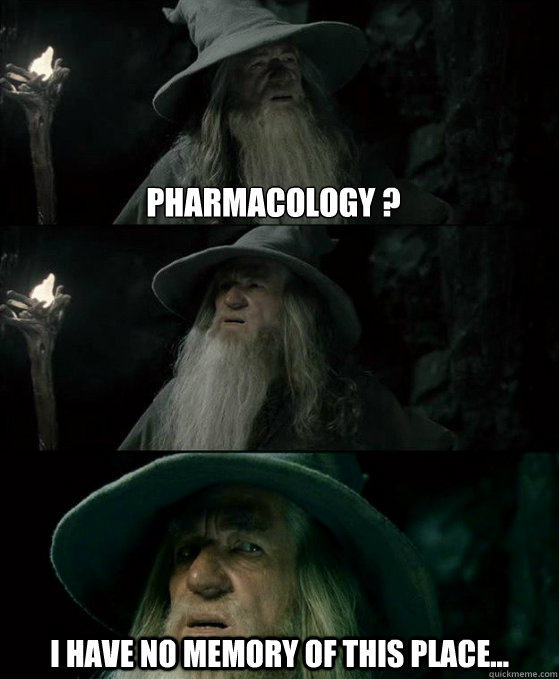
It is a subject that gets mixed up inside your brain even by listening people discussing drugs.

This blog post is an effort dedicated to making Pharmacology easier (just a bit) and fun (quite unlikely) by the use of mnemonics. Mnemonics are a great way to help ease the pressure on your nerves and they can be very helpful for remembering drug names and their side effects.
Funny and Easy to Remember Pharmacology Mnemonics
Personally, I find majority of the pre-existing Pharmacology mnemonics boring as they consist of redundant riddles. And ironically some were even harder to memorize than the drug itself. 😀 So, I always tried making mnemonics of my own and it worked because my brain works on a higher dimension of creativity while studying. 😀
I’d like to thank my esteemed colleagues, the batch of 2013-14 from Bolan Medical College, Quetta (Pakistan) who also contributed to this blog post.
Here are funny and interesting Pharmacology Mnemonics which we hope you will find useful while studying this subject. 🙂
CREDIT: Aurangzaib Baloch (batch 2013-14, Bolan Medical College, Quetta)
Mnemonic For Anti Tuberculosis Drugs
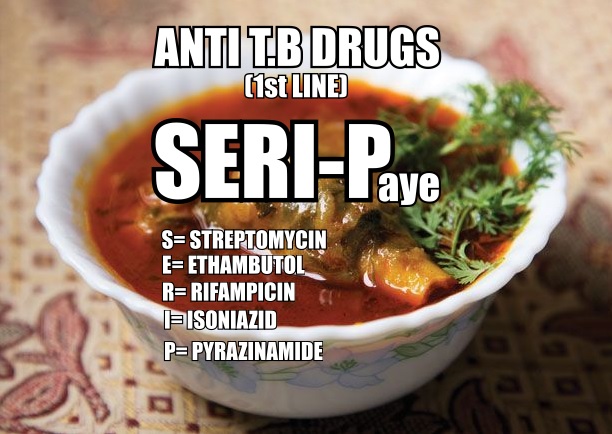
SERI-Paye (A South-Asian food with key ingredients like trotters (or hoof) of a goat, buffalo or sheep)
S= Streptomycin
E= Ethambutol
R= Rifampicin
I= Isoniazid
P= Pyrazinamide
Mnemonic for Adverse Effects of Cephalosporins
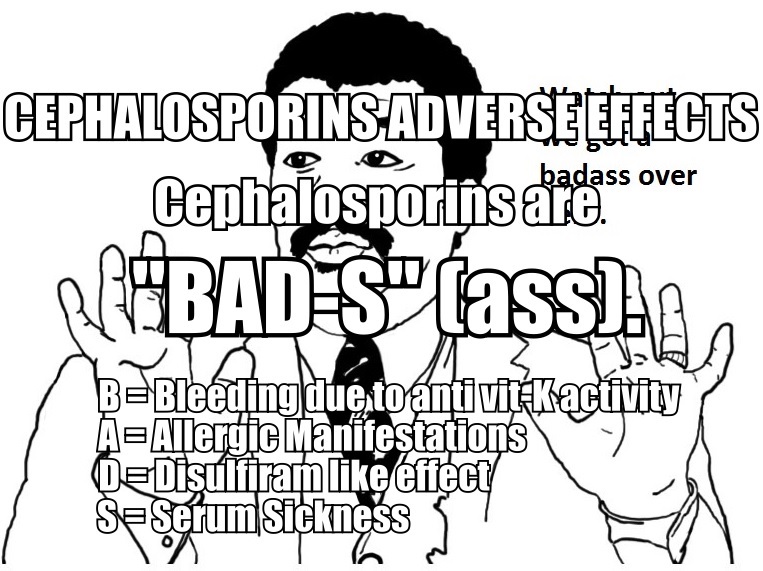
Cephalosporins are “BAD-S” (ass).
B= Bleeding due to anti vitamin-K activity
A= Allergic Manifestations
D= Disulfiram-like effect
S= Serum Sickness
Mnemonic for Adverse Effects of Aminoglycosides
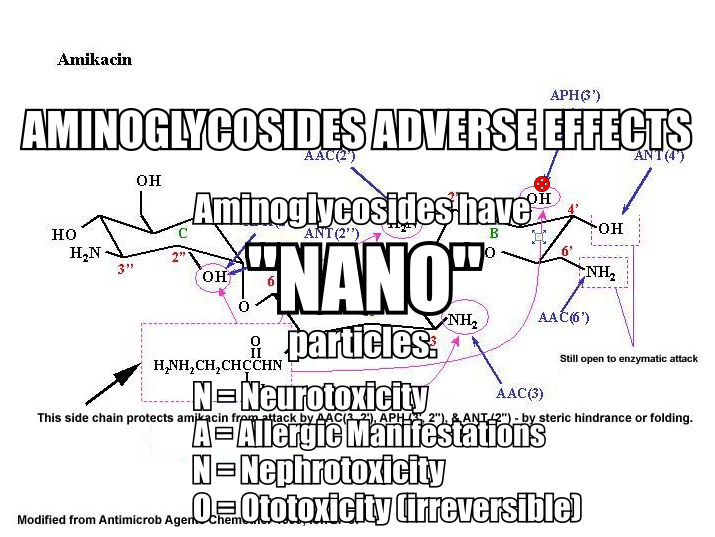
Aminoglycosides have “NANO” particles.
N= Neurotoxicity
A= Allergic Manifestations
N= Nephrotoxicity
O= Ototoxicity (irreversible)
Mnemonic for Adverse Effects of Anti-Fungal Drugs
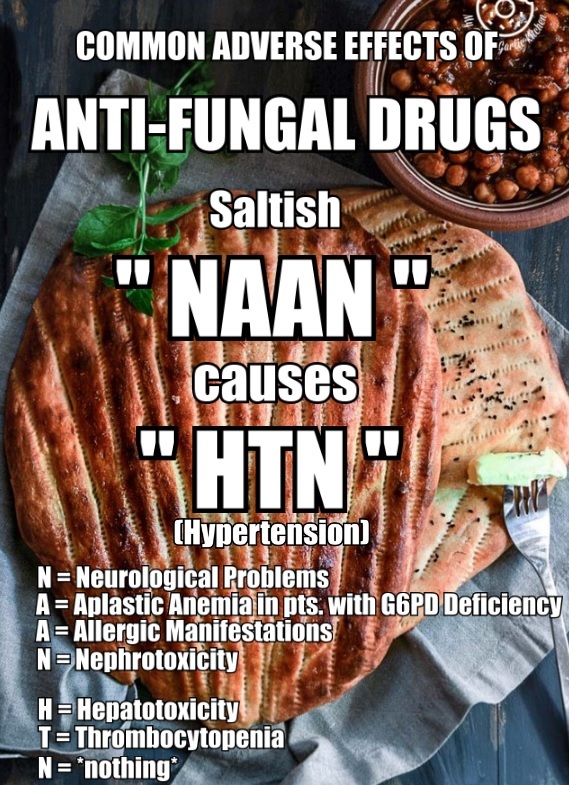
Saltish “NAAN” causes “HTN” (hypertension).
N= Neurological Problems
A= Aplastic Anemia in patients with G6PD deficiency
A= Allergic Manifestations
N= Nephrotoxicity
H= Heptotoxicity
T= Thromobocytopenia
N= *nothing, sorry* 😀
Mnemonics for Adverse Effects of Beta Blockers
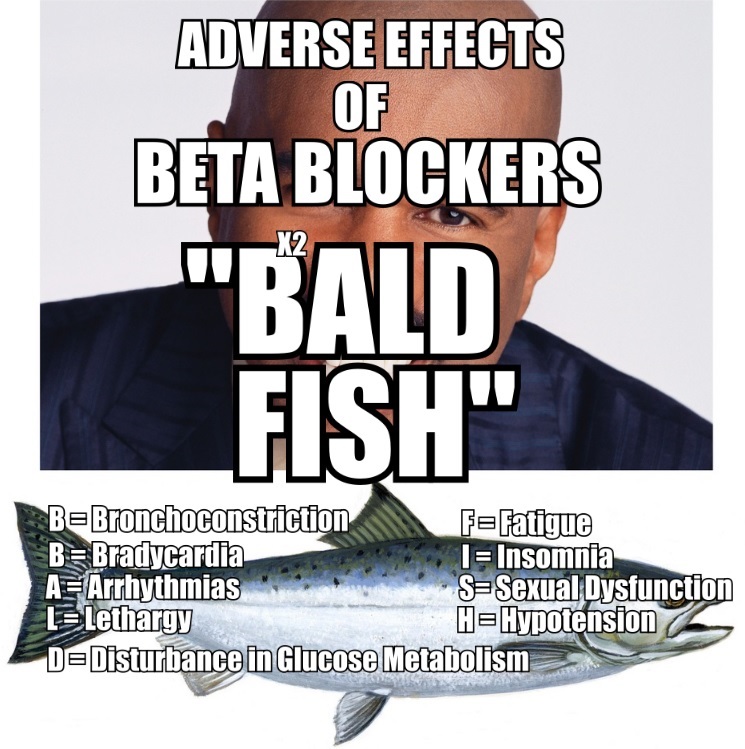
“BALD FISH”.
B= Bronchoconstriction
B= Bradycardia
A= Arrhythmias
L= Lethargy
D= Disturbance in Glucose Metabolism
F= Fatigue
I= Insomnia
S= Sexual Dysfunction
H= Hypotension
Mnemonic for Adverse Effects of Sulfonamides
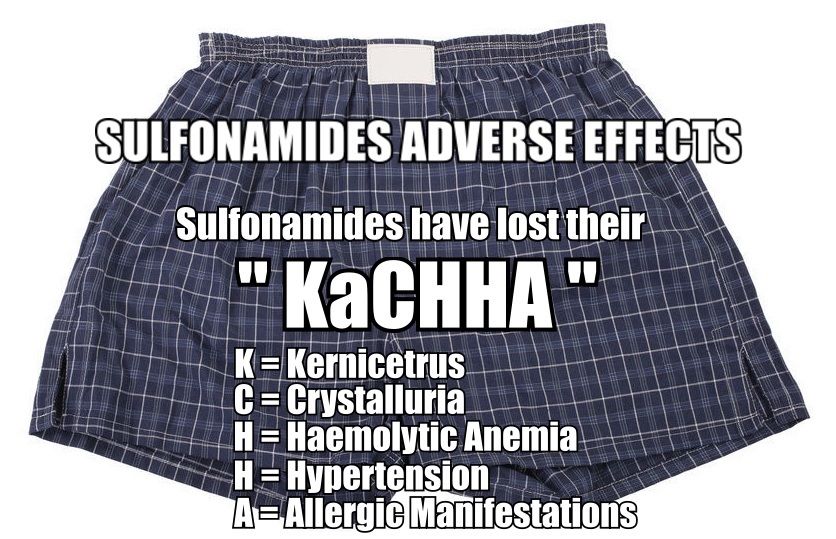
Sulfonamides have lost their “KaCHHA” (Kachha is for underwear in Hindi)
K= Kernicetrus
C= Crystalluria
H= Haemolytic Anemia
H= Hypertension
A= Allergic Manifestations
Mnemonic for Adverse Effects Fluroquinolones

“Ta-Da” : Indicates an impressive entrance or a dramatic announcement
Fluroquinolones say “TA-DAa”!
T= Tendon Rupture
A= Allergic Manifestation
D= Dizziness & Diarrhea
A= Aplastic Anemia
Mnemonic for Inducers of Cytochrome P-450

“BERPing” (real word is “burp”)
B= Barbiturates
E= Ethanol
R= Rifampicin
P= Phenytoin
Mnemonic for Inhibitors of Cytochrome P-450
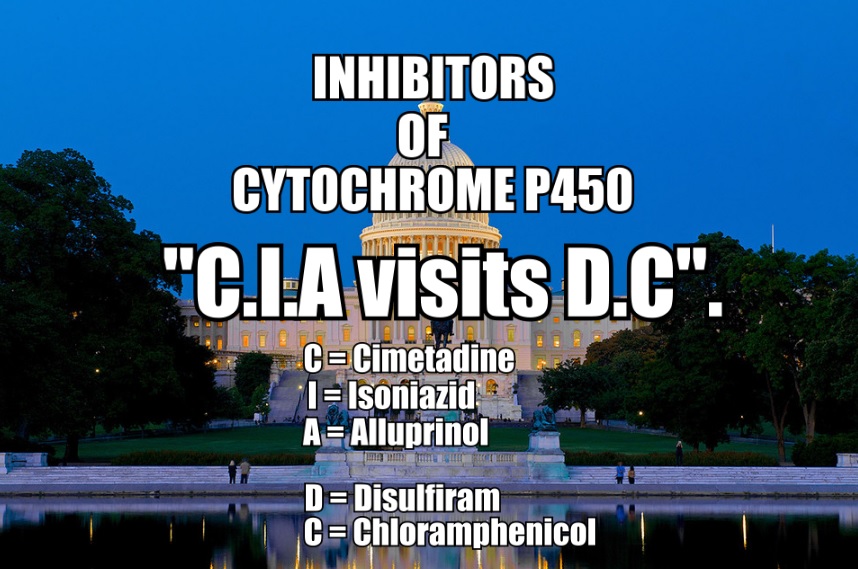
“C.I.A visits D.C“.
C= Cimetadine
I= Isoniazid
A= Alluprinol
D= Disulfiram
C= Chloramphenicol
CREDIT: Dr. Yasir Amir Baloch (MBBS, MRCP-UK)
Mnemonic for Pre-Anesthetic Drugs

“OBAMA”
O= Opoids
B= Barbiturates & Benzodiazpenes
A= Anti-Histamines
M= Muscle Relaxants
A= Anti-Cholinergics
CREDIT: Shaher Bano | Batch: 2013-14 | MBBS
Mnemonic for Selective Alpha-1 Blockers (Adrenergic Antagonists / Sympatholytics)
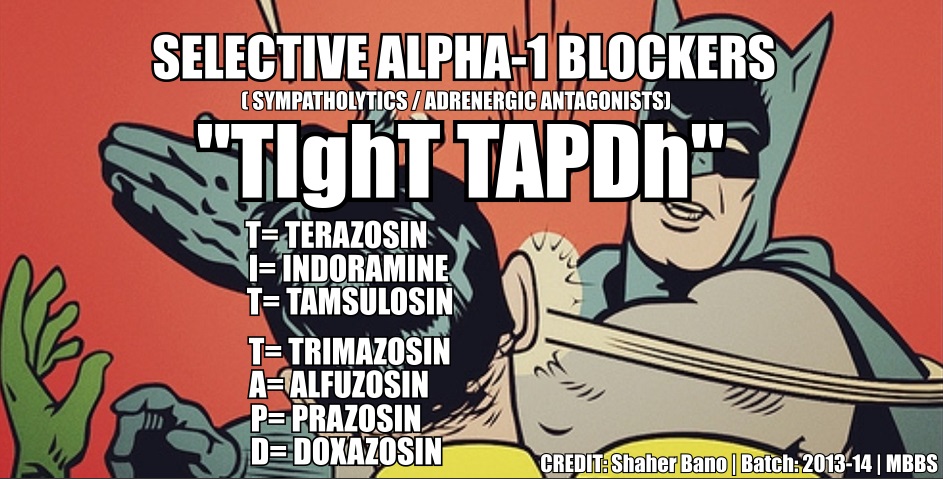
“TIghT TAPDh” (meaning: tight slap)
T= Terazosin
I= Indoramine
T= Tamsulosin
T= Trimazosin
A= Alfuzosin
P= Prazosin
D= Doxazosin
Mnemonic for Potassium Sparing Diuretics
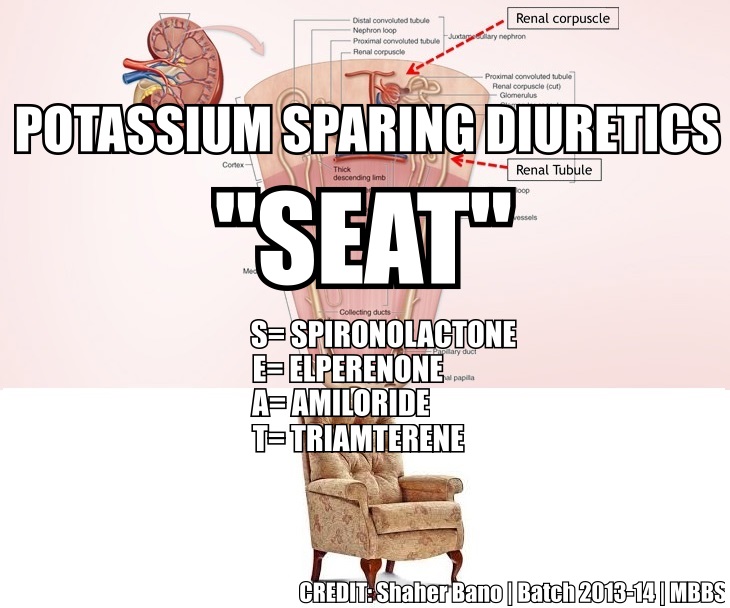
“SEAT”
S= Spironolactone
E= Elperenone
A= Amiloride
T= Triamterene
Mnemonic for Carbonic Anhydrase Inhibitor
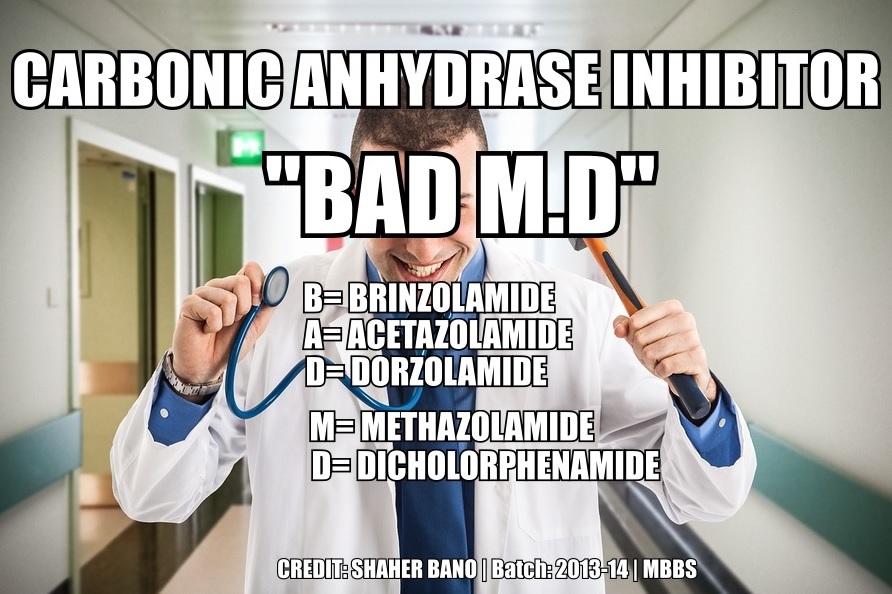
“BAD M.D”
B= Brinzolamide
A: Acetazolamide
D= Dorzolamide
M= Methazolamide
D= Dicholorphenamide
Mnemonic for Beta Adrenergic Agonists used in Chronic Obstructive Pulmonary Disease (COPD)
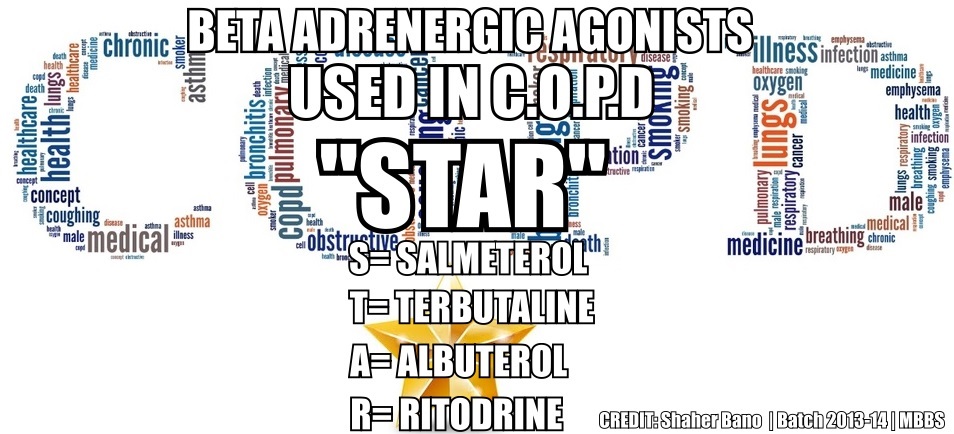
“STAR”
S= Salmeterol
T= Terbutaline
A= Albuterol
R= Ritodrine
Mnemonic for Parenteral Anti-Coagulants
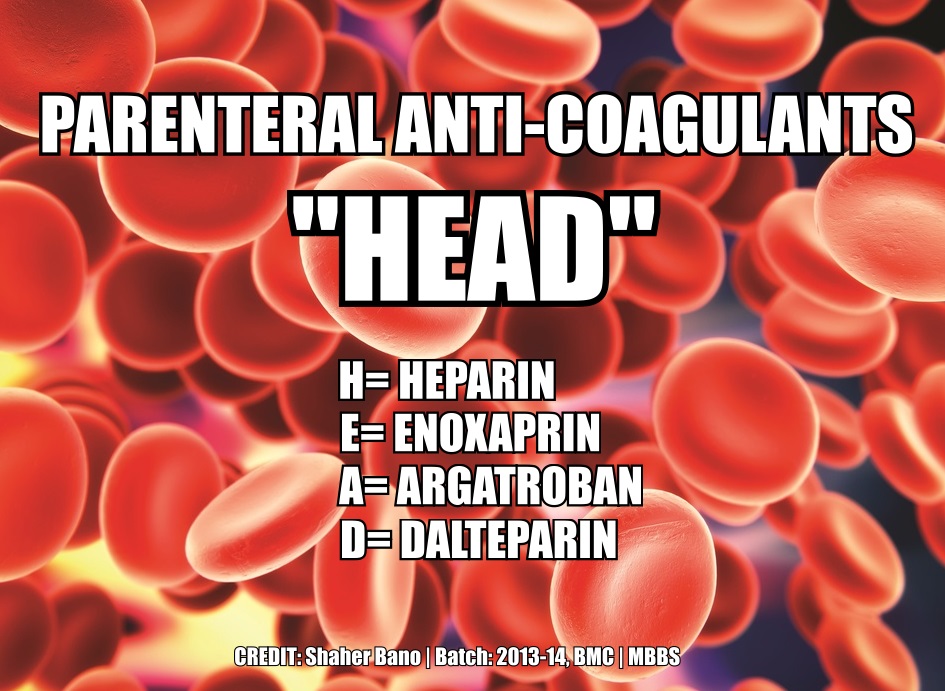
“HEAD”
H= Heparin
E= Enoxaprin
A= Argatroban
D= Dalteparin
CREDIT: Taqqadus Khan | Batch: 2013-14, BMC | MBBS
Mnemonic for Drugs following Zero-Order Kinetics
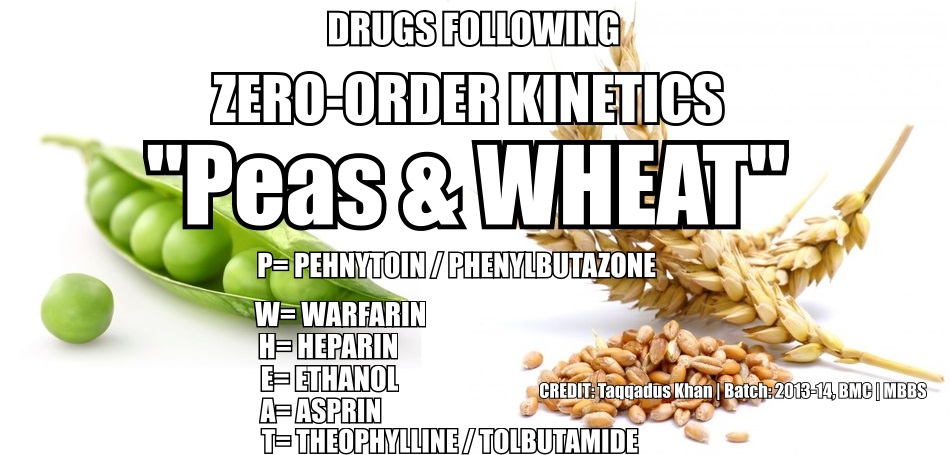
“Peas & WHEAT“
P= Phenytoin / Phenylbutazone
W= Warfarin
H= Heparin
E= Ethanol
A= Asprin
T= Theophylline / Tolbutamide
CREDIT: Sagheer Ahmad Tareen | Batch: 2013-14, BMC | MBBS
Mnemonic Drugs Used in Migraine
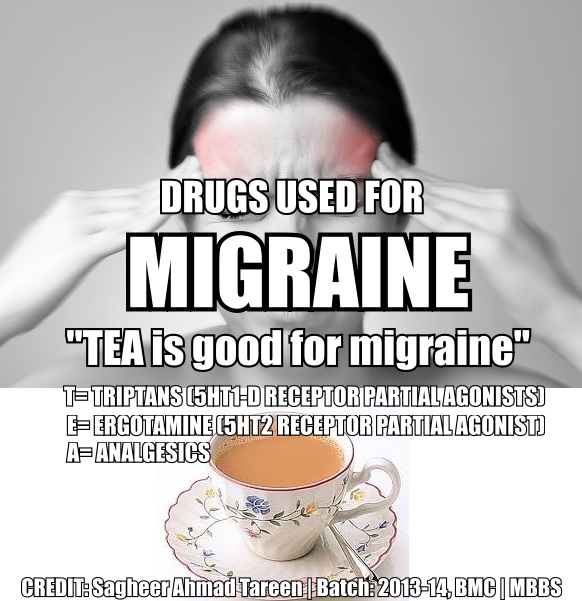
“TEA”
T= Triptans (5HT1-D Receptor Partial Agonists)
E= Ergotamine (5HT2 Receptor Partial Agonist)
A= Analgesics
Credit: Abeera Tareen | Batch: 2013-14, BMC | MBBS
Mnemonic for Mono Amine Oxidase Inhibitors
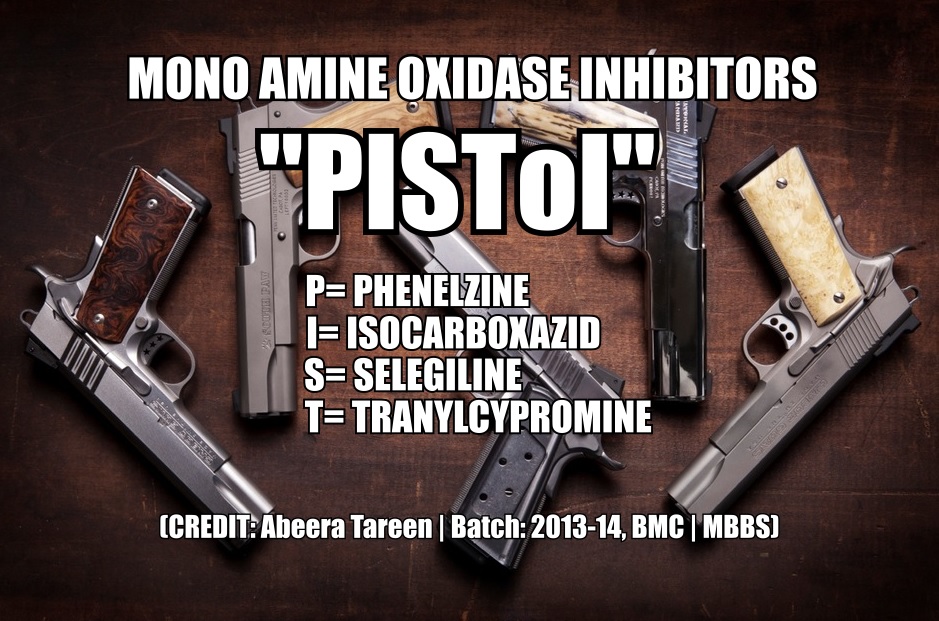
“PISTol“
P= Phenelzine
I= Isocarboxazid
S= Selegiline
T= Tranylcypromine
Credit: Sadia Idrees | Batch: 2013-14, BMC | MBBS
Mnemonic for Side Effects of Aspirin
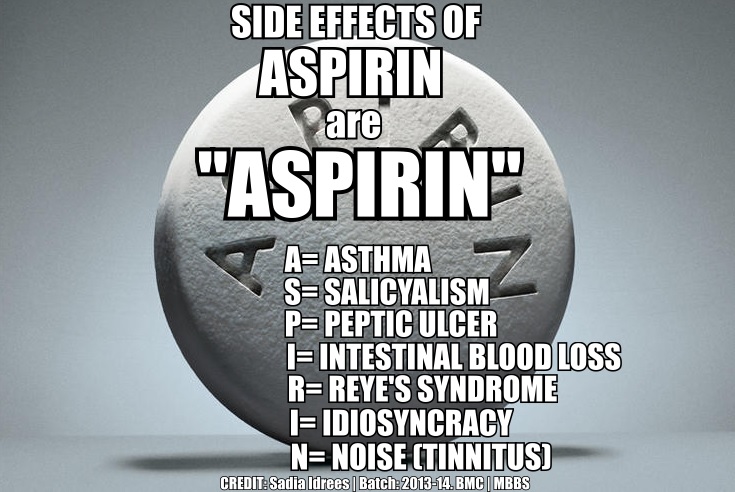
“ASPIRIN”
A= Asthma
S= Salicyalism
P= Peptic Ulcer
I= Intestinal Blood Loss
R= Reye’s Syndrome
I= Idiosyncracy
N= Noise (Tinnitus)
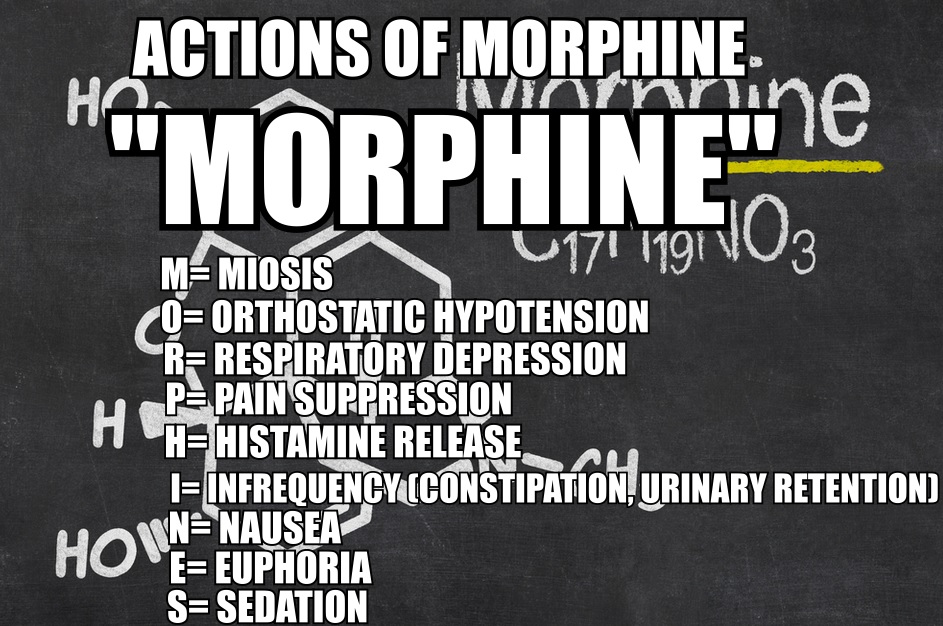
“MORPHINE”
M= Miosis
O= Orthostatic Hypotension
R= Respiratory Depression
P= Pain Suppression
H= Histamine Release
I= Infrequency (constipation etc)
N= Nausea
E= Euphoria
S= Sedation
That’s it! 🙂
We hope you find this article useful while studying Pharmacology. If you have created Pharmacology mnemonics of your own then please drop us your mnemonics below in the comment box and we will publish them here next to your name. 🙂

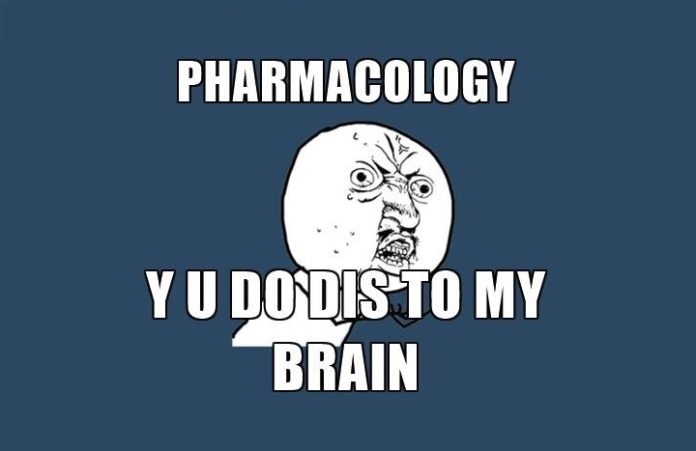

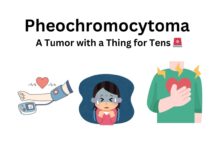
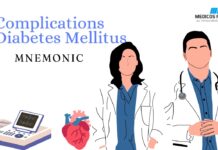
![Carcinoid Syndrome Mnemonic [Easy-to-memorize] Carcinoid Syndrome Mnemonic](https://www.medicosrepublic.com/wp-content/uploads/2024/08/Carcinoid-Syndrome-Mnemonic-Easy-to-memorize-218x150.jpg)

![Stages of Neurocysticercosis Mnemonic [Vegans Can’t Get Neurocysticercosis] Stages of Neurocysticercosis Mnemonic](https://www.medicosrepublic.com/wp-content/uploads/2023/08/Stages-of-Neurocysticercosis-Mnemonic-Vegans-Cant-Get-Neurocysticercosis-1-218x150.jpg)
![Manual of Clinical Paramedic Procedures 1st Edition PDF Free Download [Direct Link] Manual of Clinical Paramedic Procedures 1st Edition PDF](https://www.medicosrepublic.com/wp-content/uploads/2023/07/Manual-of-Clinical-Paramedic-Procedures-1st-Edition-PDF-150x150.jpg)
![Liver Disease in Children 5th Edition PDF Free Download [Direct Link] Liver Disease in Children 5th Edition PDF](https://www.medicosrepublic.com/wp-content/uploads/2022/08/Liver-Disease-in-Children-5th-Edition-PDF-Free-Download-150x150.jpg)
![Wound Care Pocket Guide: Clinical Reference 2nd Edition PDF Free Download [Direct Link] Wound Care Pocket Guide Clinical Reference 2nd Edition PDF](https://www.medicosrepublic.com/wp-content/uploads/2022/08/Wound-Care-Pocket-Guide-Clinical-Reference-2nd-Edition-PDF-Free-Download-150x150.jpg)
![Basic and Clinical Pharmacology 15th Edition PDF Free Download [Direct Link] Basic and Clinical Pharmacology 15th Edition PDF](https://www.medicosrepublic.com/wp-content/uploads/2022/08/Basic-and-Clinical-Pharmacology-15th-Edition-PDF-Free-Download-150x150.jpg)
![Transitions in Nursing: Preparing for Professional Practice PDF Free Download [Direct Link] Transitions in Nursing: Preparing for Professional Practice PDF](https://www.medicosrepublic.com/wp-content/uploads/2018/08/Transitions-in-Nursing-Preparing-for-Professional-Practice-PDF-Free-Download-150x150.jpg)
![Medical Physiology: Principles for Clinical Medicine 5th Edition PDF Free Download [Direct Link]](https://www.medicosrepublic.com/wp-content/uploads/2022/06/Medical-Physiology-Principles-for-Clinical-Medicine-5TH-Edition-PDF-Free-Download-696x365-1-150x150.jpg)
![Barron’s MCAT Flash Cards PDF Free Download [Direct Link] Barron's MCAT Flash Cards PDF](https://www.medicosrepublic.com/wp-content/uploads/2023/01/Barrons-MCAT-Flash-Cards-PDF-Free-Download-150x150.jpg)
![Review Of Medical Microbiology & Immunology 13th Edition PDF Free Download [Direct Link] Review Of Medical Microbiology & Immunology 13th Edition PDF](https://www.medicosrepublic.com/wp-content/uploads/2022/08/Review-Of-Medical-Microbiology-Immunology-13th-Edition-PDF-Free-Download-150x150.jpg)
![Whiplash and Hidden Soft Tissue Injuries: When, Where and Why to Refer Auto Accident Patients PDF Free Download [Direct Link] Whiplash and Hidden Soft Tissue Injuries When, Where and Why to Refer Auto Accident Patients PDF](https://www.medicosrepublic.com/wp-content/uploads/2023/02/Whiplash-and-Hidden-Soft-Tissue-Injuries-When-Where-and-Why-to-Refer-Auto-Accident-Patients-PDF-Free-Download-150x150.jpeg)
![Jawetz, Melnick & Adelberg’s Medical Microbiology 26th Edition PDF Free Download [Direct Link] Jawetz, Melnick & Adelberg's Medical Microbiology 26th Edition PDF](https://www.medicosrepublic.com/wp-content/uploads/2022/11/Jawetz-Melnick-Adelbergs-Medical-Microbiology-26th-Edition-PDF-Free-Download-150x150.jpg)
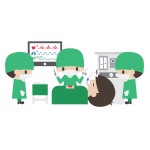




Wow extremly easy and well presented mnemonics i must say the writer of this article is a brilliant thinker and a genious !!!
Nice one…Will help.a lot with pharmacology memorization
Beautiful, God bless you
How do I download this?
THANK YOU , God bless you to let us who want to learn but have less money ^^